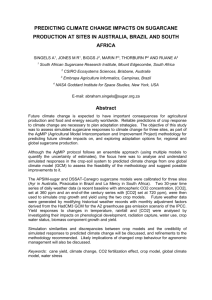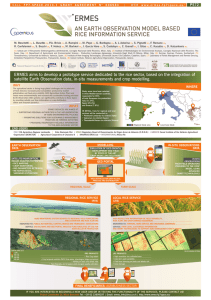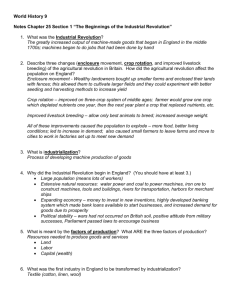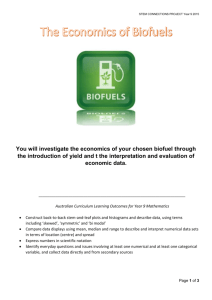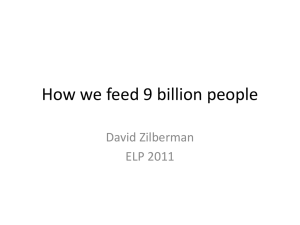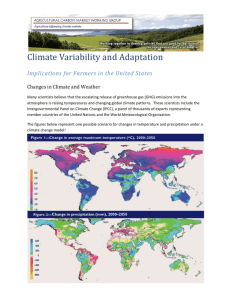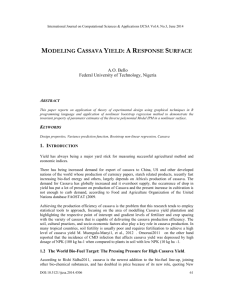gbc20346-sup-0006-tableS3
advertisement
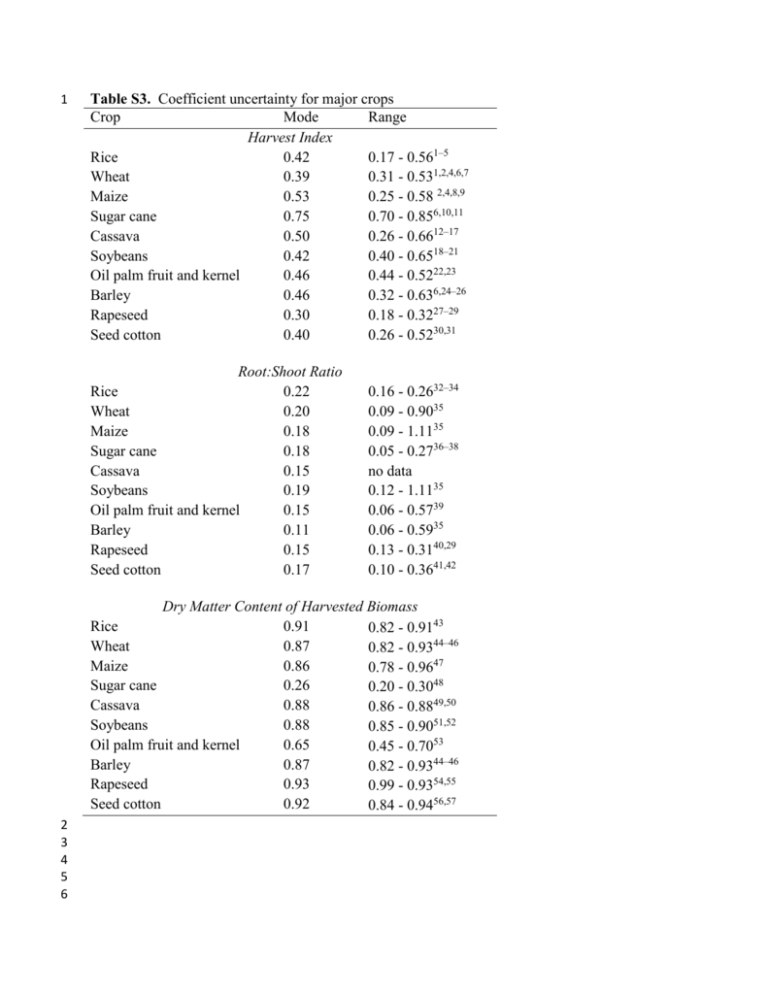
1 Table S3. Coefficient uncertainty for major crops Crop Mode Range Harvest Index Rice 0.42 0.17 - 0.561–5 Wheat 0.39 0.31 - 0.531,2,4,6,7 Maize 0.53 0.25 - 0.58 2,4,8,9 Sugar cane 0.75 0.70 - 0.856,10,11 Cassava 0.50 0.26 - 0.6612–17 Soybeans 0.42 0.40 - 0.6518–21 Oil palm fruit and kernel 0.46 0.44 - 0.5222,23 Barley 0.46 0.32 - 0.636,24–26 Rapeseed 0.30 0.18 - 0.3227–29 Seed cotton 0.40 0.26 - 0.5230,31 Root:Shoot Ratio Rice 0.22 Wheat 0.20 Maize 0.18 Sugar cane 0.18 Cassava 0.15 Soybeans 0.19 Oil palm fruit and kernel 0.15 Barley 0.11 Rapeseed 0.15 Seed cotton 0.17 0.16 - 0.2632–34 0.09 - 0.9035 0.09 - 1.1135 0.05 - 0.2736–38 no data 0.12 - 1.1135 0.06 - 0.5739 0.06 - 0.5935 0.13 - 0.3140,29 0.10 - 0.3641,42 Dry Matter Content of Harvested Biomass Rice 0.91 0.82 - 0.9143 Wheat 0.87 0.82 - 0.9344–46 Maize 0.86 0.78 - 0.9647 Sugar cane 0.26 0.20 - 0.3048 Cassava 0.88 0.86 - 0.8849,50 Soybeans 0.88 0.85 - 0.9051,52 Oil palm fruit and kernel 0.65 0.45 - 0.7053 Barley 0.87 0.82 - 0.9344–46 Rapeseed 0.93 0.99 - 0.9354,55 Seed cotton 0.92 0.84 - 0.9456,57 2 3 4 5 6 7 8 9 10 11 12 13 14 15 16 17 18 19 20 21 22 23 24 25 26 27 28 29 30 31 32 33 34 35 36 37 38 39 40 41 42 43 44 45 46 47 48 49 50 51 52 References 1. 2. 3. 4. 5. 6. 7. 8. 9. 10. 11. 12. 13. 14. 15. 16. 17. 18. 19. Hay, R. (1995), Harvest Index - a Review of Its Use in Plant-Breeding and Crop Physiology. Ann. Appl. Biol., 126, 197–216. Yang, J., and Zhang, J. (2010), Crop management techniques to enhance harvest index in rice. J. Exp. Bot., 61, 3177–89. Bueno, C. S., and Lafarge, T. (2009), Higher crop performance of rice hybrids than of elite inbreds in the tropics: 1. Hybrids accumulate more biomass during each phenological phase. Field Crops Res., 112, 229–37. Fischer, R. A., and Edmeades, G. O. (2010), Breeding and Cereal Yield Progress. Crop Sci., 50, S85 – S98. Atlin, G. N., Lafitte, H. R., Tao, D., Laza, A., Amante, A., and Courtois, B. (2006), Developing rice cultivars for high-fertility upland systems in the Asian tropics. Field Crops Res., 97, 43–52. Larcher, W. (1995), Physiological plant ecology: ecophysiology and stress physiology of functional groups. Springer-Verlag, Berlin; New York. Foulkes, M. J., Slafer, G. A., Davies, W. J., et al. (2011), Raising yield potential of wheat. III. Optimizing partitioning to grain while maintaining lodging resistance. J. Exp. Bot., 62, 469–86. Hay, R. K. M., and Gilbert, R. A. (2001), Variation in the harvest index of tropical maize: evaluation of recent evidence from Mexico and Malawi. Ann. Appl. Biol., 138, 103–9. Lorenz, A. J., Gustafson, T. J., Coors, J. G., and de Leon, N. (2010), Breeding Maize for a Bioeconomy: A Literature Survey Examining Harvest Index and Stover Yield and Their Relationship to Grain Yield. Crop Sci., 50, 1–12. Dillewijn, C. van. (1952), Botany of sugarcane. Chronica Botanica Co., Waltham, Mass. FAO. Feeding Pigs in the Tropics, Chapter 3: Sugarcane. Silva, T. S., Lima e Silva, P. S., Braga, J. D., da Silveira, L. M., and de Sousa, R. P. (2013), Planting density and yield of cassava roots. Rev. Cienc. Agron., 44, 317–24. Rosenthal, D. M., Slattery, R. A., Miller, R. E., et al. (2012), Cassava about-FACE: Greater than expected yield stimulation of cassava (Manihot esculenta) by future CO2 levels. Glob. Change Biol., 18, 2661–75. Alves de Albuquerque, J. de A., Sediyama, T., Arcanjo Alves, J. M., da Silva, A. A., and Pereira Uchoa, S. C. (2012), Cultivation of cassava and beans in intercropping systems held in Coimbra in the State of Minas Gerais, Brazil. Rev. Cienc. Agron., 43, 532–8. Kawuki, R. S., Ferguson, M., Labuschagne, M. T., et al. (2011), Variation in qualitative and quantitative traits of cassava germplasm from selected national breeding programmes in sub-Saharan Africa. Field Crops Res., 122, 151–6. Kawano, K. (2003), Thirty years of cassava breeding for productivity - Biological and social factors for success. Crop Sci., 43, 1325–35. Okeke, J. Cassava varietal improvement for processing and utilization in livestock feedsCassava as Livestock Feed in Africa. FAO, Nigeria. Betzelberger, A. M., Yendrek, C. R., Sun, J., et al. (2012), Ozone Exposure Response for U.S. Soybean Cultivars: Linear Reductions in Photosynthetic Potential, Biomass, and Yield. Plant Physiol., 160, 1827–39. West, T. O., Bandaru, V., Brandt, C. C., Schuh, A. E., and Ogle, S. M. (2011), Regional uptake and release of crop carbon in the United States. Biogeosciences, 8, 2037–46. 53 54 55 56 57 58 59 60 61 62 63 64 65 66 67 68 69 70 71 72 73 74 75 76 77 78 79 80 81 82 83 84 85 86 87 88 89 90 91 92 93 94 95 96 97 98 20. Board, J. E., and Maricherla, D. (2008), Explanations for decreased harvest index with increased yield in soybean. Crop Sci., 48, 1995–2002. 21. Cui, S. Y., and Yu, D. Y. (2005), Estimates of relative contribution of biomass, harvest index and yield components to soybean yield improvements in China. Plant Breed., 124, 473–6. 22. Wahid, M. (2008), Oil Palm--Achievements and PotentialCrop Science - ICSC2004. Brisbane, Australia. 23. Breure, C. (1986), Parent Selection for Yield and Bunch Index in the Oil Palm in WestNew-Britain. Euphytica, 35, 65–72. 24. Peltonen-Sainio, P., Muurinen, S., Rajala, A., and Jauhiainen, L. (2008), Variation in harvest index of modern spring barley, oat and wheat cultivars adapted to northern growing conditions. J. Agric. Sci., 146, 35–47. 25. Bertholdsson, N.-O., and Brantestam, A. K. (2009), A century of Nordic barley breedingEffects on early vigour root and shoot growth, straw length, harvest index and grain weight. Eur. J. Agron., 30, 266–74. 26. Hakala, K., Keskitalo, M., and Eriksson, C. (2008), Nutrient uptake and biomass accumulation for eleven different field crops. Agric. Food Sci., 18, 366–87. 27. Mead, M. I., White, I. R., Nickless, G., Wang, K.-Y., and Shallcross, D. E. (2008), An estimation of the global emission of methyl bromide from rapeseed (Brassica napus) from 1961 to 2003. Atmos. Environ., 42, 337–45. 28. Franzaring, J., Hoegy, P., and Fangmeier, A. (2008), Effects of free-air CO2 enrichment on the growth of summer oilseed rape (Brassica napus cv. Campino). Agric. Ecosyst. Environ., 128, 127–34. 29. Svecnjak, Z., and Rengel, Z. (2006), Nitrogen utilization efficiency in canola cultivars at grain harvest. Plant Soil, 283, 299–307. 30. Zhang, H. J., Dong, H. Z., Li, W. J., and Zhang, D. M. (2012), Effects of Soil Salinity and Plant Density on Yield and Leaf Senescence of Field-Grown Cotton. J. Agron. Crop Sci., 198, 27–37. 31. Unlu, M., Kanber, R., Koc, D. L., Tekin, S., and Kapur, B. (2011), Effects of deficit irrigation on the yield and yield components of drip irrigated cotton in a mediterranean environment. Agric. Water Manag., 98, 597–605. 32. Kato, Y., and Okami, M. (2010), Root growth dynamics and stomatal behaviour of rice (Oryza sativa L.) grown under aerobic and flooded conditions. Field Crops Res., 117, 9–17. 33. Roy, K. S., Bhattacharyya, P., Neogi, S., Rao, K. S., and Adhya, T. K. (2012), Combined effect of elevated CO2 and temperature on dry matter production, net assimilation rate, C and N allocations in tropical rice (Oryza sativa L.). Field Crops Res., 139, 71–9. 34. Ziska, L. H., Namuco, O., Moya, T., and Quilang, J. (1997), Growth and yield response of field-grown tropical rice to increasing carbon dioxide and air temperature. Agron. J., 89, 45–53. 35. Bolinder, M. A., Janzen, H. H., Gregorich, E. G., Angers, D. A., and VandenBygaart, A. J. (2007), An approach for estimating net primary productivity and annual carbon inputs to soil for common agricultural crops in Canada. Agric. Ecosyst. Environ., 118, 29–42. 36. Jangpromma, N., Thammasirirak, S., Jaisil, P., and Songsri, P. (2012), Effects of drought and recovery from drought stress on above ground and root growth, and water use efficiency in sugarcane (Saccharum officinarum L.). Aust. J. Crop Sci., 6, 1298. 37. Bakker, H. (1999), Sugarcane Cultivation and Management. Springer. 99 100 101 102 103 104 105 106 107 108 109 110 111 112 113 114 115 116 117 118 119 120 121 122 123 124 125 126 127 128 129 130 131 132 133 134 135 136 137 138 139 140 141 142 38. Smith, J., Lawn, R., and Nable, R. (1999), Investigations into the root:shoot relationship of sugarcane, and some implications for crop productivity in the presence of sub-optimal soil conditions. Proc Aust Soc Sugar Cane Technol, 21, 108–13. 39. Syahrinudin. (2005), The potential of oil palm and forest plantations for carbon sequestration on degraded land in Indonesia. Cuvillier Verlag. 40. Ashraf, M., Shahbaz, M., and Ali, Q. (2013), Drought-Induced Modulation in Growth and Mineral Nutrients in Canola (brassica Napus L.). Pak. J. Bot., 45, 93–8. 41. Mcmichael, B., and Quisenberry, J. (1991), Genetic-Variation for Root Shoot Relationships Among Cotton Germplasm. Environ. Exp. Bot., 31, 461–70. 42. Dong, H., Niu, Y., Li, W., and Zhang, D. (2008), Effects of cotton rootstock on endogenous cytokinins and abscisic acid in xylem sap and leaves in relation to leaf senescence. J. Exp. Bot., 59, 1295–304. 43. IRRI International Rice Research Institute. Measuring Moisture Content of Rice. 44. Joint FAO/WHO Food Standards Programme. (1994), November 31, Report of the Ninth Session of the CODEX Committee on Cereals, PUlses, and Legumes. 45. McKenzie, B., and Van Fossen, L. (1995), Managing dry grain in storage. Purdue University Cooperative Extension Service. 46. Wicke, W., and Hellevang, K. (2012), Storage ManagementThe Small Grains Field Guide. University of Minnesota Extension. 47. McNeill, S., and Montross, M. Corn Harvesting, Handling, Drying, and StorageA Comprehensive Guide to Corn Management in Kentucky. University of Kentucky Multidisciplinary Extension Team, University of Kentucky. 48. Pate, F., Alvarez, J., Phillips, J., and Eiland, B. K. (2002), Sugarcane as a Cattle Feed: Production and Utilization. University of Florida Extension. 49. (2012), Dried Cassava Chips--Specification. The African Organization for Standardization, Nairobi. 50. Ospina, B., and Wheatley, C. (1991), Processing of cassava tuber meals and chips. FAO, Rome. 51. Joint FAO/WHO Food Standards Programme. (1995), Codex Standard for Certain Pulses. CODEX STAN 171-1989. 52. Summer, P. (2000), Harvesting, drying and storage of soybeans. Cooperative Extension Service, The Universtiy of Georgia. 53. Abbas, Z., Yeow, Y. K., Shaari, A. H., Khalid, K., Hassan, J., and Saion, E. (2005), Complex permittivity and moisture measurements of oil palm fruits using an open-ended coaxial sensor. IEEE Sens. J., 5, 1281–7. 54. Hellevang, K. (2011), Canola Drying and Storage Management. North Dakota State University Extension. 55. Government of Alberta, A. A. and R. D. Storage of Canola. fact sheet. 56. Parker, R. E., and Wooten, O. B. (1964), Sources of moisture in mechanically harvested seed cotton and its effects on cotton quality. U.S. Dept. of Agriculture, Washington. 57. National Cotton Council of America. Just Build It: Seed-Cotton Storage and Handling in Modules. National Cotton Council of America.
